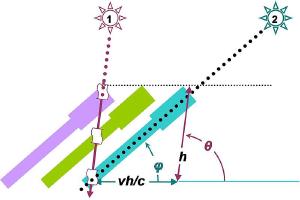Blog
Line of Sight
14 December 2013
Yesterday I wrote about Roemer’s observations of Jupiter’s moon Io, and how this demonstrated the speed of light was finite. I also noted that Roemer’s observations did not convince all astronomers that light had a finite speed.
You might think Roemer’s experiment is pretty conclusive, but keep in mind that his experiment was published in 1676. Kepler’s laws (upon which Roemer’s experiment relied) were first published in 1619, and Newton’s gravitational theory wasn’t published until 1687. Kepler’s laws were not fully accepted until after Newton’s work, and it wasn’t until the early 1700s that they were referred to as “laws.”
Roemer is typically credited with the first measurement of the speed of light, but it is an experiment by James Bradley that put the last nail in the coffin of instantaneous light. Bradley’s results were presented in a 1729 letter to Edmond Halley. The letter described a phenomenon known as stellar aberration.1
Bradley’s understanding of the effect assumed that light consisted of corpuscles, which are basically particles of light that aren’t affected by gravity. This means they would always move in a straight line. This would mean the motion of the Earth would cause a star to appear to be an a position that is slightly different from its actual position (as seen in the image below, though the angle is highly exaggerated).
 Brews ohare, CC BY-SA 3.0
Brews ohare, CC BY-SA 3.0The effect is similar to the effect of falling rain. If rain is falling straight down, then if you stand in the rain you see it fall straight down. But if you run in the rain, it appears to be falling slightly toward you. You are moving through the rain, but from your perspective it looks like the rain is falling from a point slightly ahead of you. The same effect is true for starlight. The motion of the Earth means the position of star appears shifted. If light traveled at infinite speed, then there would be no stellar aberration at all.
What’s interesting about Bradley’s observations is that he wasn’t trying to demonstrate that light had a finite speed. He was trying to prove that the Earth moves by observing the parallax of a star. If you hold your thumb up against a distant background, and look at it with one eye and then the other, your thumb will appear to shift against the background. This is known as parallax. The motion of the Earth around the Sun means that we observe stars from a slightly different perspective throughout the year. So nearby stars exhibit a parallax shift.
Bradley tried to measure parallax by observing the star gamma Draconis. With careful observation he was able to measure a shift. The same effect was observed for other stars, and the shifts were of the same amount. This meant the shift he observed couldn’t be due to parallax, since stars at different distances should have different parallax shifts. The observed shifts were also opposite of that expected for parallax. Eventually Bradley realized the shift was due to the finite speed of light.
So Bradley failed in his attempt to measure parallax (such attempts were not successful until 1838) but he was successful in demonstrating that the Earth moved. Sometimes you get the proof you seek, but not in the way you expect.
We now have a much more sophisticated understanding of light, and stellar aberration is known to be an effect of special relativity. We compensate for the effect when making observations from both ground-based and space-based telescopes.
Bradley’s observation was further step to understanding the nature of light. It also led to a number of theories about light and the luminiferous ether. But that’s a story for another day.
A Letter from the Reverend Mr. James Bradley Savilian Professor of Astronomy at Oxford, and F.R.S. to Dr.Edmond Halley Astronom. Reg. &c. Giving an Account of a New Discovered Motion of the Fix’d Stars Bradley, J Philosophical Transactions (1683-1775). 1753-01-01. 35:637–661 ↩︎